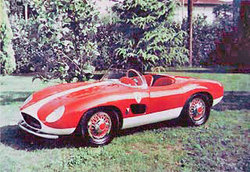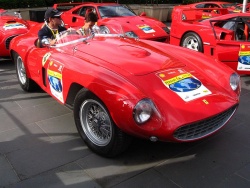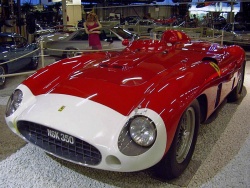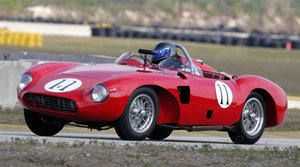Ferrari Monza
| Ferrari Monza | |
|---|---|
| aka | Ferrari TF Ferrari Mondial |
| Production | 1953–1957 |
| Class | World Sportscar Championship |
| Engine | Lampredi I4 |
| Predecessor | Ferrari 250 MM |
| Successo | Ferrari 250 Testa Rossa |
In the early 1950s, Ferrari shifted from using the compact Gioacchino Colombo-designed V12 engine in its smallest class of sports racers to a line of four cylinder engines designed by Aurelio Lampredi. Inspired by the success of the light and reliable 2.5 L 553 F1 car, the four cylinder sports racers competed successfully through the late 1950s, culminating with the famed 500 Mondial and 750 Monza.
One important stylistic difference between most four-cylinder Ferraris is that they lacked the hood scoops common on V12 models. The V12 cars used downdraft carburettors located centrally in the "valley" of the engine, while the inline-engined fours used side-draft units and thus did not need the hood scoops.
1953
1953 was a breakout year for Ferrari, beginning with the new World Sportscar Championship series. The company augmented their traditional V12-powered 250 MM with the new 340 MM and 375 MM and introduced the new four-cylinder 625 TF and 735 S models. With this profusion of cars, Ferrari was able to sweep the first running of the sportscar championship.
625 TF
| 250px | |
| Ferrari 625 TF | |
|---|---|
| Production | 1953 |
| Class | WSC racer |
| Predecessor | Ferrari 250 MM |
| Successor | Ferrari 500 Mondial |
| Engine | 2.5 L (2498 cc) Lampredi I4 |
The first four-cylinder closed-wheel sports racer from Ferrari was the 625 TF of 1953. Resembling the Vignale-designed 250 MM barchetta in most respects, the 625 TF used a 2.5 L (2498 cc/152 in³) straight-4 lifted from the 625 F1 car instead of the 250's 3.0 L V12. It was a small car, with the same 2250 mm (89 in) wheelbase as the 250 but even lighter at 730 kg (1610 lb). The engine produced 220 hp (164 kW) at 7000 rpm and could push the little roadster to over 240 km/h (150 mph).
The lightweight car debuted at the hands of Mike Hawthorn at Monza on June 29, 1953. Although it could not keep up on the long straights at that track, Hawthorn still brought the car to fourth place at its debut.
A single closed 625 TF coupe, one of the last Ferraris designed and built by Vignale, was created in the Spring of 1953.
735 S

| |
| Ferrari 735 S | |
|---|---|
| Production | 1953 |
| Class | WSC racer |
| Predecessor | Ferrari 250 MM |
| Successor | Ferrari 750 Monza |
| Engine | 2.9 L (2942 cc) Lampredi I4 |
The same day that the 625 TF debuted, another car was fielded for Alberto Ascari. Sporting an enlarged 2.9 L (2942 cc/179 in³) engine, Ascari's 735 S was more capable at Monza, leading the race until he collided with a 250 MM. The 735 S was a barchetta bodied by Carrozzeria Autodromo with recessed headlights, a drooping grille, and fender vents.
1954-1955
The 1954 and 1955 seasons were the heyday of the four-cylinder Ferrari sports racer. The company hit its stride, earning the World Sportscar Championship in 1954 and contending in 1955 despite the legendary Mercedes-Benz team. The Ferrari sports car lineup at the beginning of 1954 was made up of the 2.0 L 500 Mondial and 3.0 L 750 Monza. The team replaced the Mondial with the 500 TR later that year, and feverishly worked to hold off Mercedes-Benz, developing the larger 857 S and six-cylinder 118 LM and 121 LM. The planned V12 sports racer family, including the 250 Monza of 1954 and planned 410 S of 1955, were less notable.
500 Mondial
| Ferrari 500 Mondial | |
|---|---|
| Production | 1954 |
| Class | WSC racer |
| Predecessor | Ferrari 625 TF |
| Successor | Ferrari 500 TR |
| Engine | 2.0 L (1985 cc) Lampredi I4 |
The early experiments with Lampredi's four-cylinder engine led to the creation of the famed 500 Mondial. Named to mark the world ("Mondial") championships won by Alberto Ascari, the 500 Mondial featured a 2.0 L version of Lampredi's four cylinder engine in a small and light body with an advanced suspension. The car debuted on December 20, 1953 at the 12 Hours of Casablanca driven by Ascari and Gianluigi Villoresi, placing second to a 375 MM.
The 500 Mondial's 2.0 L (1985 cc/121 in³) engine was taken from the 500 F2 which won the world championship but was detuned to produce 170 hp (127 kW). It was extremely light at 720 kg (1590 lb) and handled well with a modern de Dion tube rear suspension.
The first 500 Mondials were coupes bodied by Carrozzeria Scaglietti, but Pinin Farina later created a series of barchettas. The Mondial remained competitive through the end of the decade, including an entry in the 1957 Mille Miglia.
750 Monza

| |
| Ferrari 750 Monza | |
|---|---|
| Production | 1954 |
| Class | WSC racer |
| Predecessor | Ferrari 735 S |
| Successor | Ferrari 857 S |
| Engine | 3.0 L (3000 cc) Lampredi I4 |
1954 saw the introduction of a new four cylinder sports racer, the 750 Monza. Sporting a three litre version of the 500 Mondial's engine, the Monza was much more powerful, with 250 hp (186 kW) available, but barely heavier at 760 kg (1675 lb). The new-style body was penned by Pinin Farina and presaged the droop-nose look of the famed 250 GTO, but it was Scaglietti's 750 Monza, with its faired-in headrest suggesting the flowing Testa Rossa that drew attention.
Mike Hawthorn and Umberto Maglioli piloted their 750 Monza to victory at Monza
on its very first race, giving the car its name. Although they were strong on the track, the Monza was unable to hold off the Mercedes-Benz 300 SLR in 1955, allowing the Germans to seize the sports car championship that Ferrari claimed in 1954.
250 Monza
- See also Ferrari 250
The 750 Monza body was mated to the 3.0 L V12 to create the 250 Monza of 1954. This combination was not pursued, however.
500 TR
| Ferrari 500 TR | |
|---|---|
| Production | 1954 |
| Class | WSC racer |
| Predecessor | Ferrari 500 Mondial |
| Successor | Ferrari 860 Monza |
| Engine | 2.0 L (1985 cc) Lampredi I4 |
As the 750 was introduced in 1954, the smaller 500 Mondial was replaced by another two liter car, the 500 TR. The first car to bear the famed Testa Rossa name, the 500 TR differed from the Mondial in many details. Among the most important was a coil spring suspension, a radical departure for Ferrari, as well as a synchronized transmission with a two-disc clutch. The 500 TR continued its predecessors tradition of light weight, coming in at just 680 kg (1500 lb), and this combined with the engine's 190 hp (142 kW) to bring stirring performance to the car.
Scaglietti built most of the 500 TRs, with three also constructed by Carrozzeria Touring, and the design aped the 750 Monza including the faired-in headrest.
857 S
| Ferrari 857 S | |
|---|---|
| Production | 1955 |
| Class | WSC racer |
| Predecessor | Ferrari 750 Monza |
| Successor | Ferrari 860 Monza |
| Engine | 3.4 L (3421 cc) Lampredi I4 |
The short-lived 857 S of 1955 was an attempt to hold off the strong Mercedes-Benz team, something the 750 Monza and 118 LM/121 LM were unable to do. An existing 750 Monza chassis received an enlarged version of Lampredi's four, now displacing 3.4 L (3421 cc/208 in³) and producing 280 hp (209 kW). The car was not competitive with the German team at the 1955 Tourist Trophy, so Lampredi went back to the drawing board for the next season.
1956
With Mercedes-Benz pulling out of international sports car racing, the 860 Monza and new 290 MM showed well throughout 1956, bringing the sports car world championship home to Mondena again. This despite the fact that Jaguar's new D-Type took the crown at the newly-restricted Le Mans and Maserati's 300 S took the Nürburgring race.
860 Monza

| |
| Ferrari 860 Monza | |
|---|---|
| Production | 1956 |
| Class | WSC racer |
| Predecessor | Ferrari 857 S |
| Successor | Ferrari 250 Testa Rossa |
| Engine | 3.4 L (3432 cc) Lampredi I4 |
Although little changed on paper from the 857 S, the 1956 860 Monza was much more competitive in international sports car racing. The engine was reworked with 102 mm (4 in) by 105 mm (4.1 in) dimensions for a total of 3.4 L (3432 cc/209 in³), though power output remained at 280 hp (209 kW). The wheelbase was lengthened by 100 mm (3.9 in) to 2350 mm (93 in), but a new front coil spring suspension, as on the 500 TR, allowed the 100 kg (220 lb) heavier car to handle well.
625 LM
| Ferrari 625 LM | |
|---|---|
| Production | 1956 |
| Class | Le Mans prototype |
| Predecessor | Ferrari 121 LM |
| Successor | Ferrari 335 S Ferrari 250 Testa Rossa |
| Engine | 2.5 L (2498 cc) Lampredi I4 |
After the 1955 Le Mans disaster, the ACO reduced engine size and restricted prototype entries for the 1956 24 Hours of Le Mans to control the speed and danger of the race. Ferrari could not enter its 1956 3.4 L 860 Monza and 3.5 L 290 MM in race, so it instead modified three 500 TR barchettas to take the larger 2.5 L engine, and entered them as the 625 LM. The engine was only slightly modified from the 625 F1 with compression reduced to 9:1 and two Weber 42DCOA carburettors used. Of the three, only the car of Gendebien/Trintignant finished, placing third to the new Jaguar D-Type.
1957
Ferrari handed off the four-cylinder sports racer line to customers at the end of 1956, choosing to focus on its own attention on the V12-powered 312 and 335 S cars.
500 TRC
| Ferrari 500 TRC | |
|---|---|
| Production | 1957 |
| Class | WSC racer |
| Predecessor | Ferrari 500 TR |
| Successor | |
| Engine | 2.0 L (1985 cc) Lampredi I4 |
The 1956/7 500 TRC was a massaged version of the successful 500 TR of the previous year. In keeping with the new C-section regulations, Ferrari widened the cockpit, added doors, fitted a windscreen, and even added a stowable convertible top. It rode on the longer 2350 mm (93 in) wheelbase of the 860 Monza and featured coil springs all around, though the live axle in the rear was retained rather than the more modern de Dion tube. The 680 kg (1500 lb) car's 190 hp (142 kW) made it quite capable, and even though it was never a works car, a 500 TRC claimed a class win at the 1958 Targa Florio.
